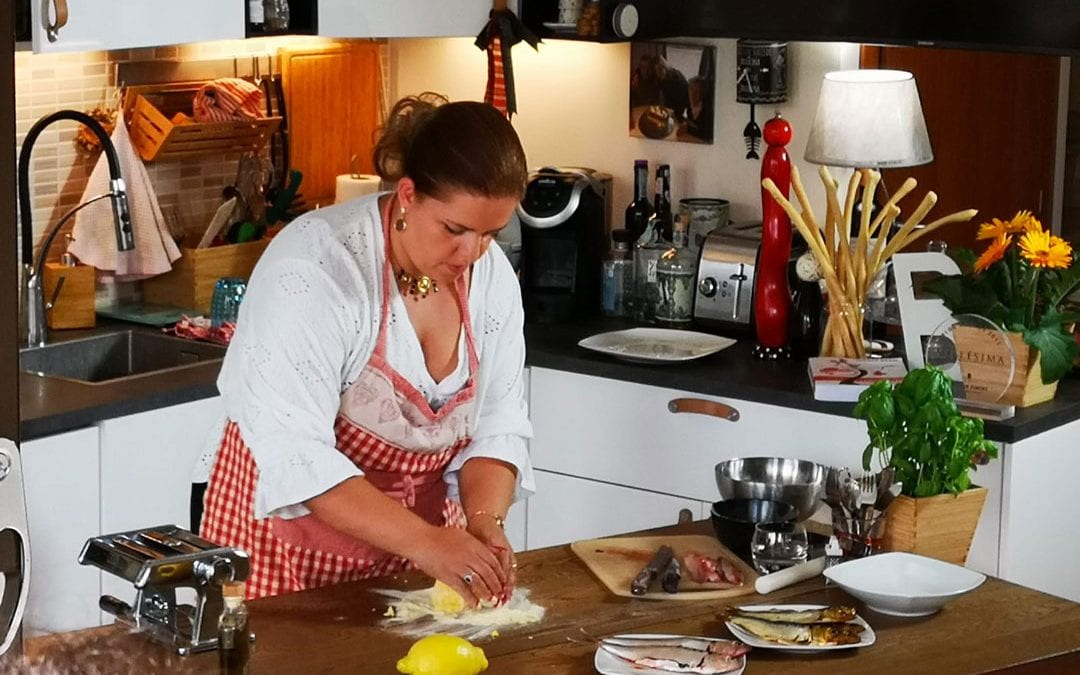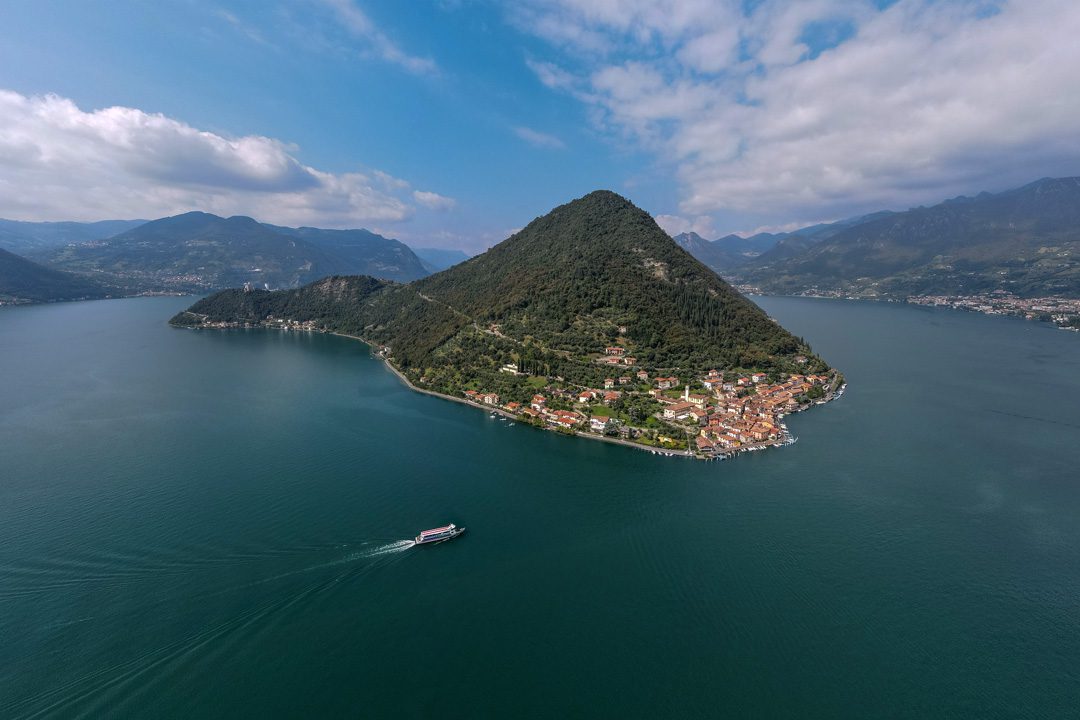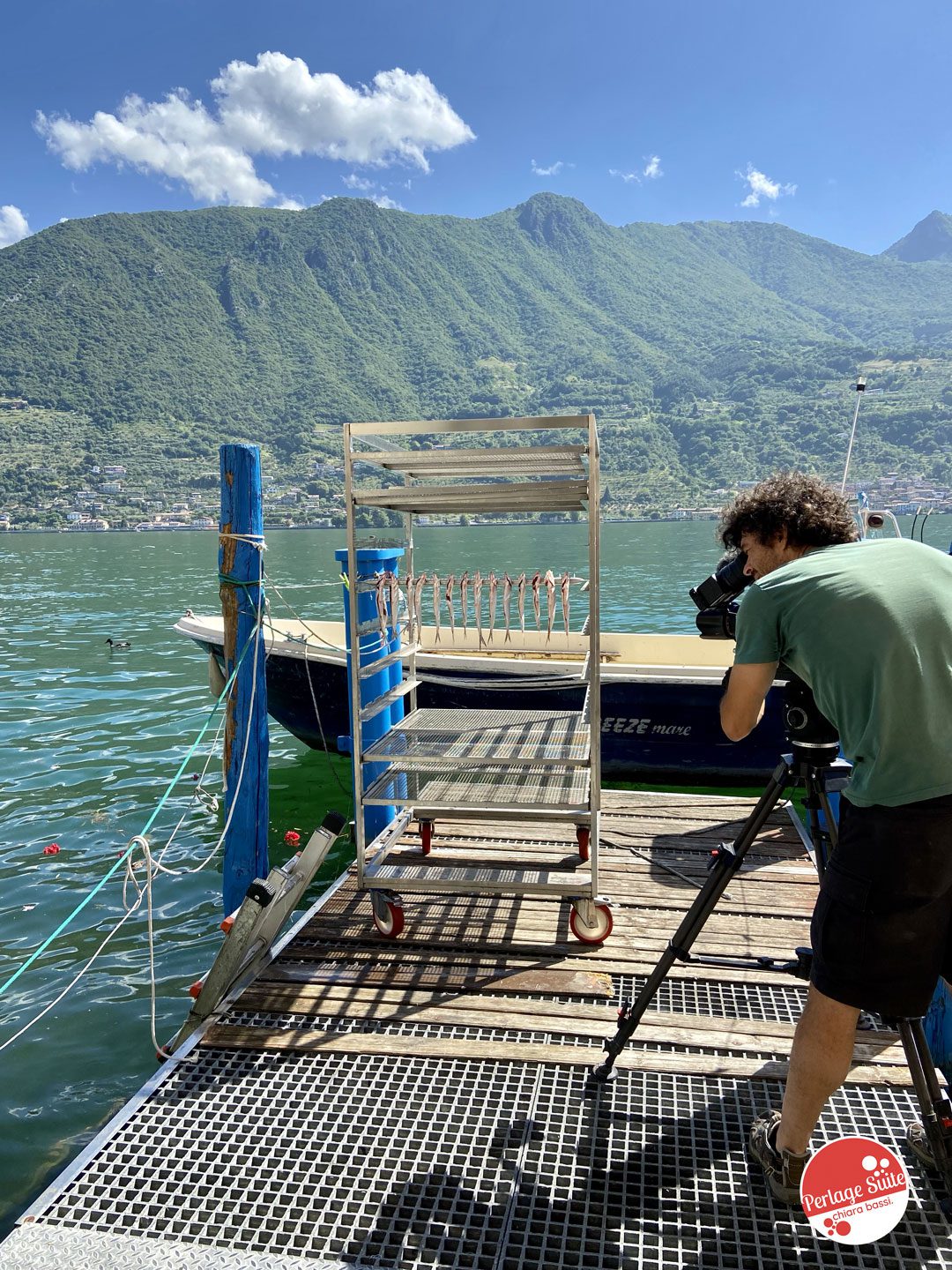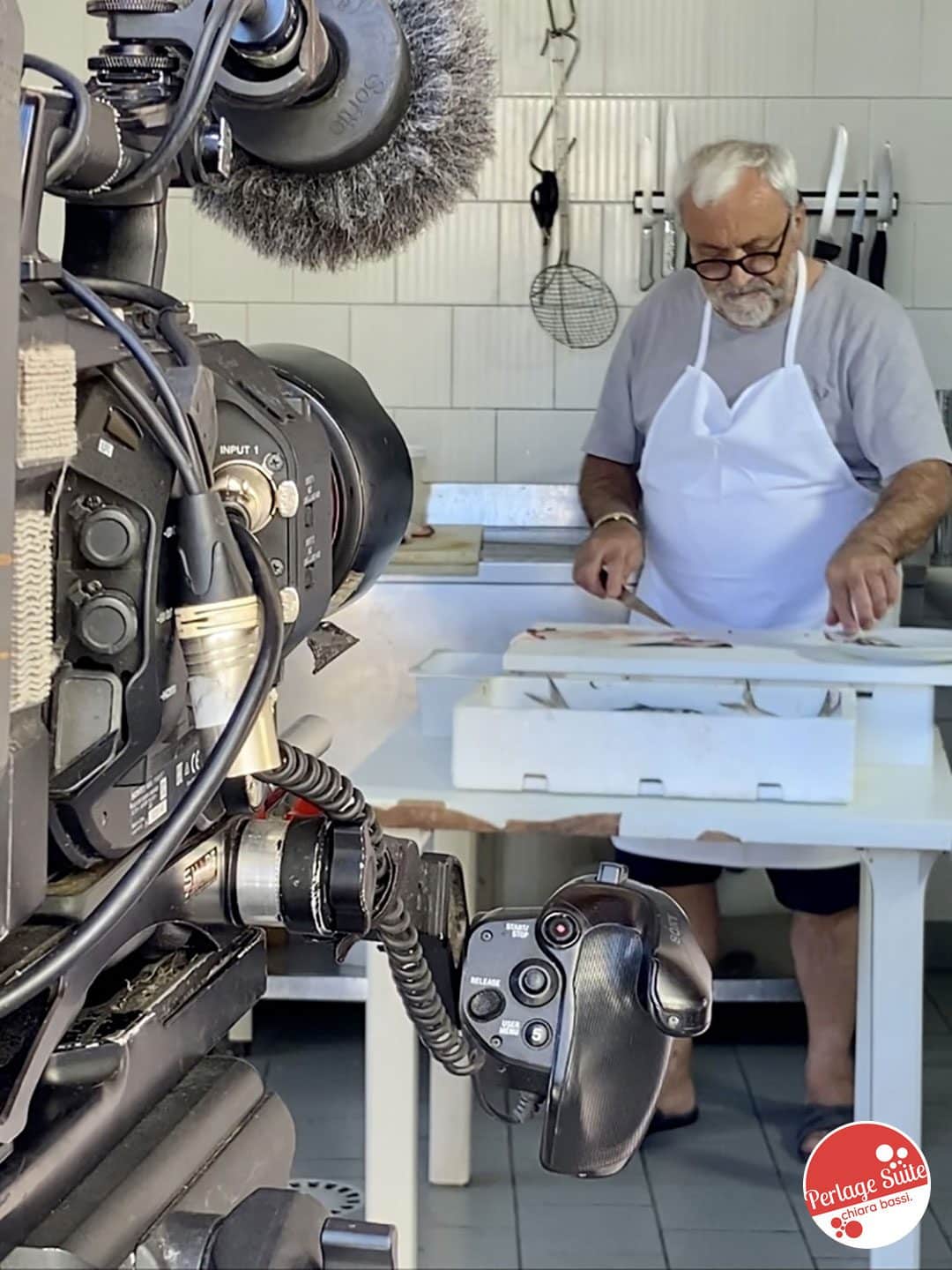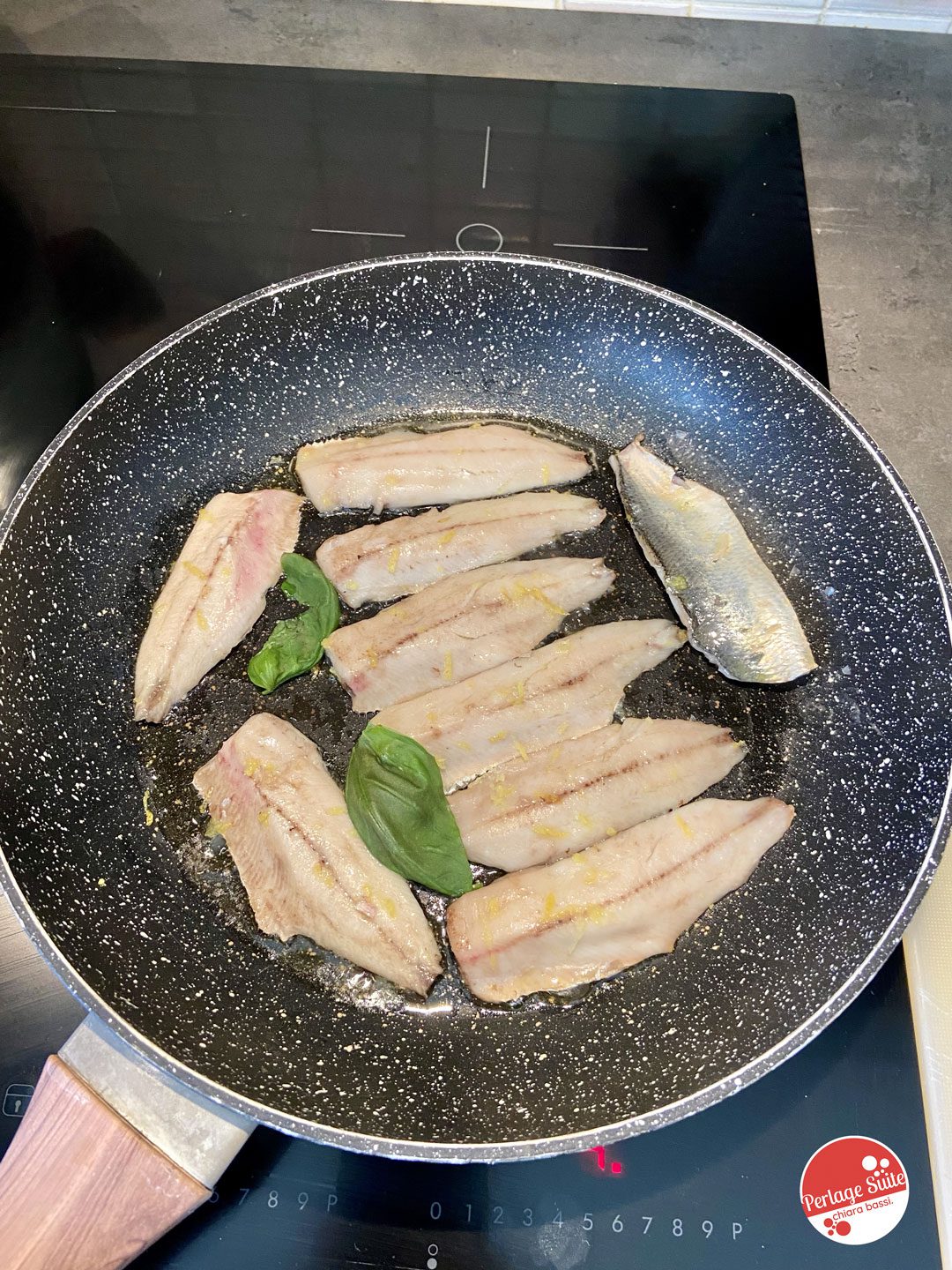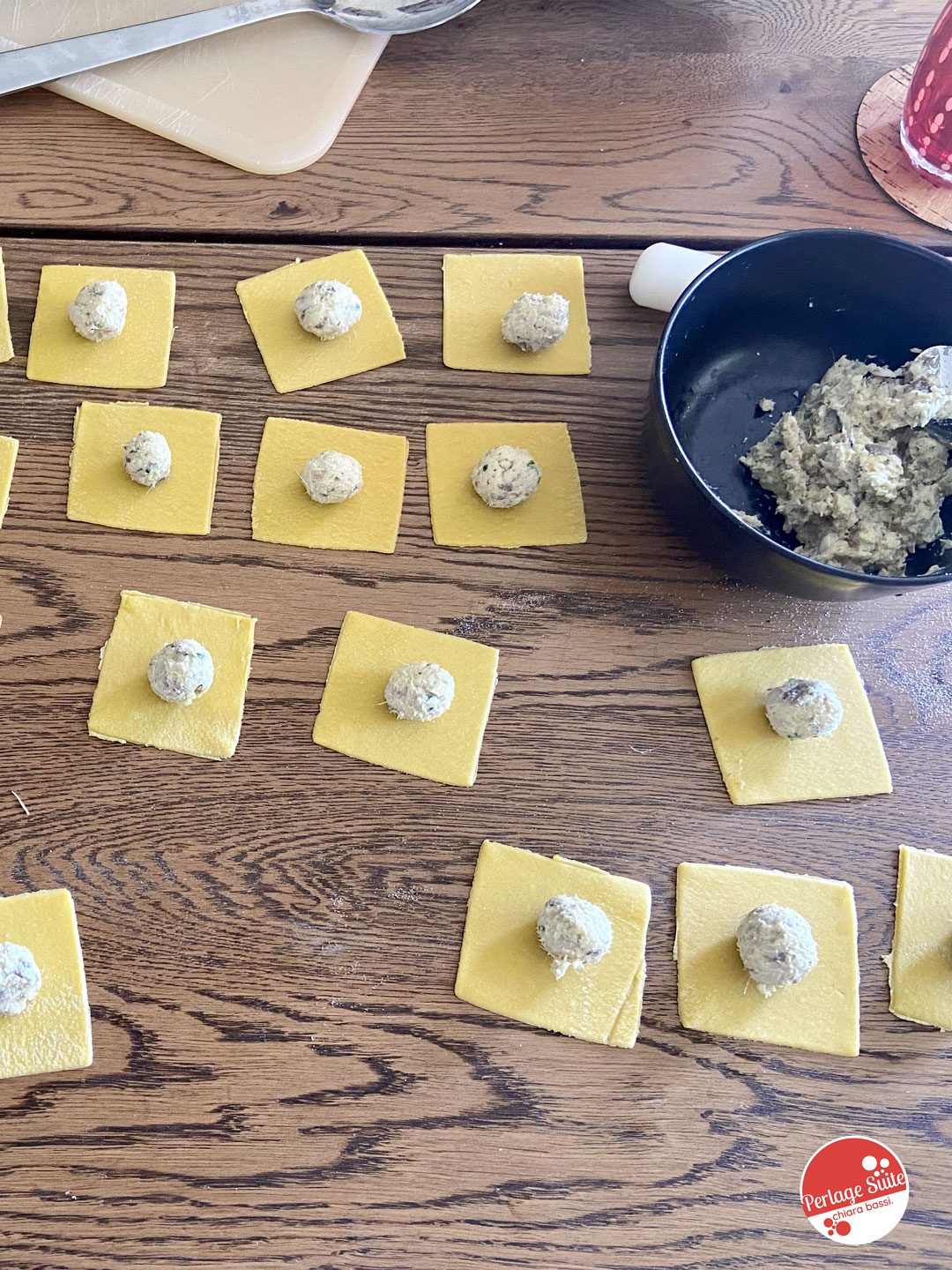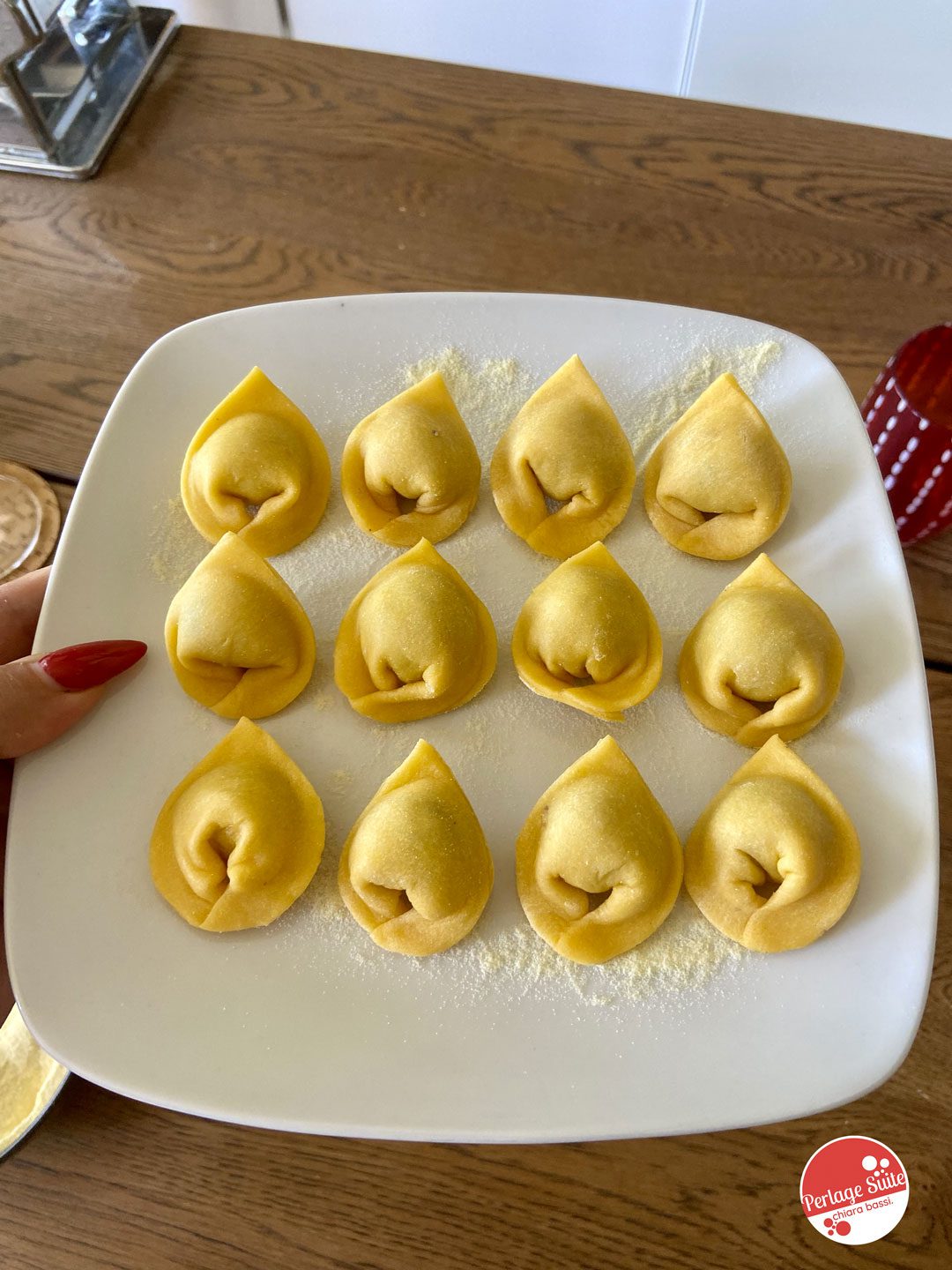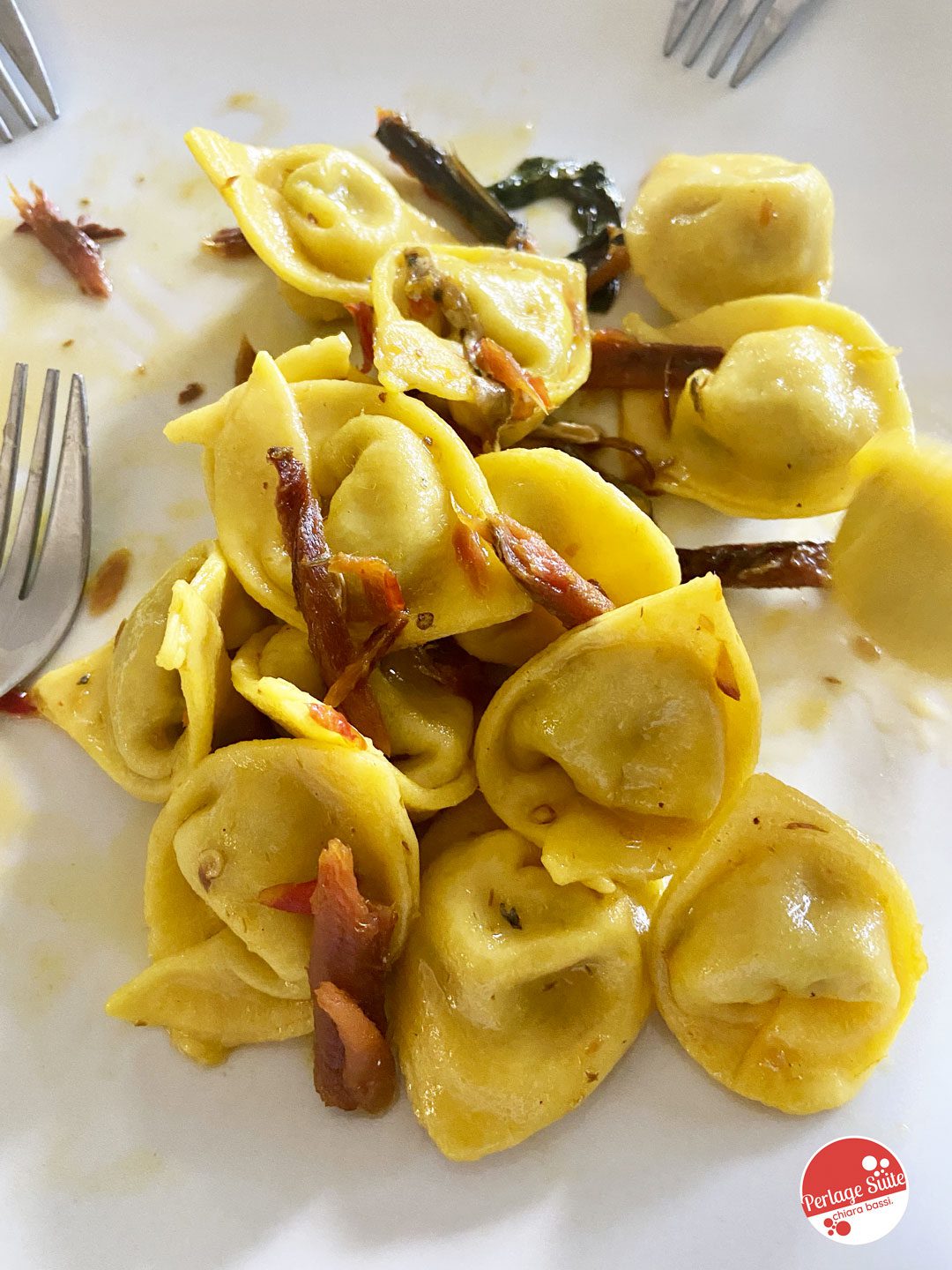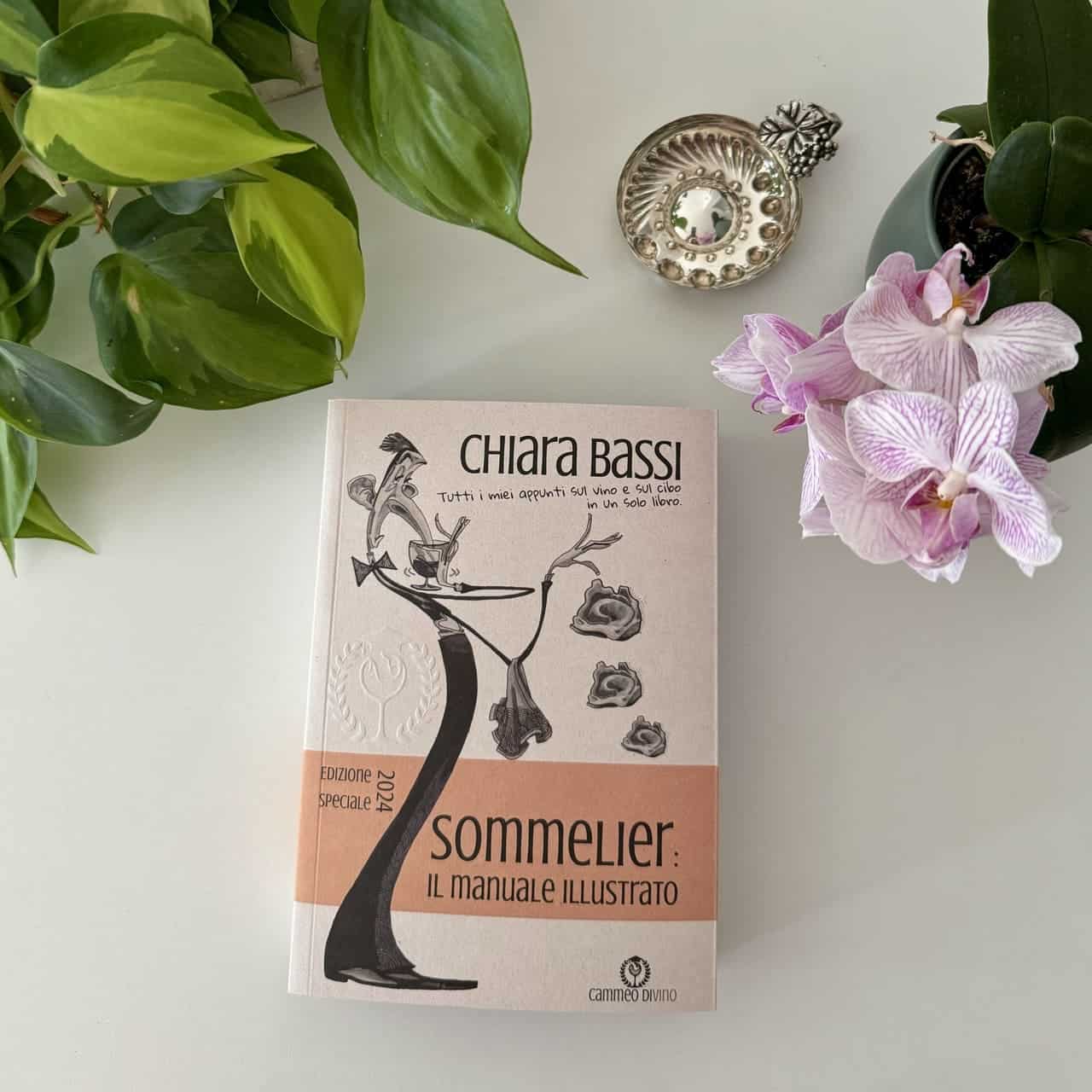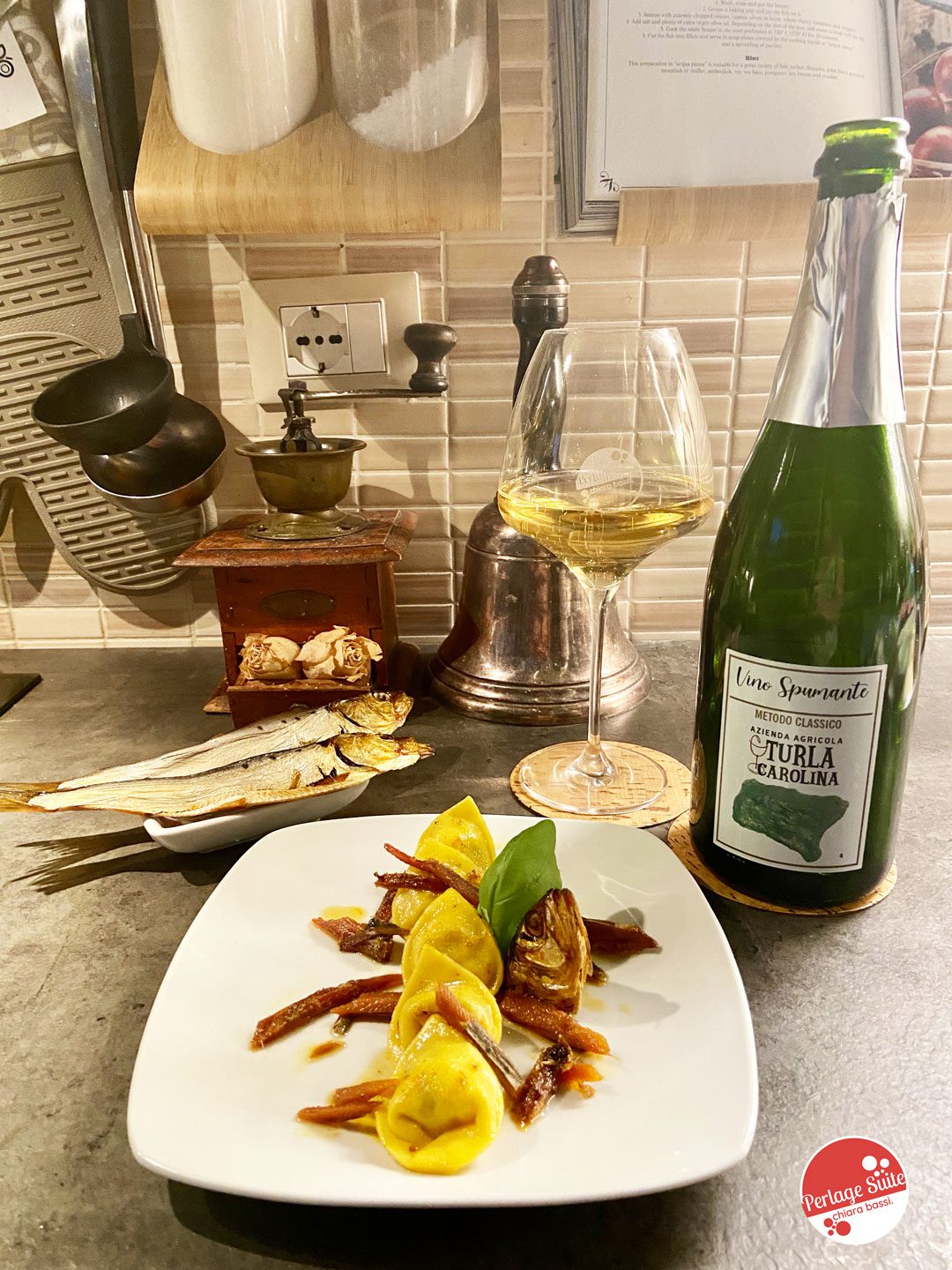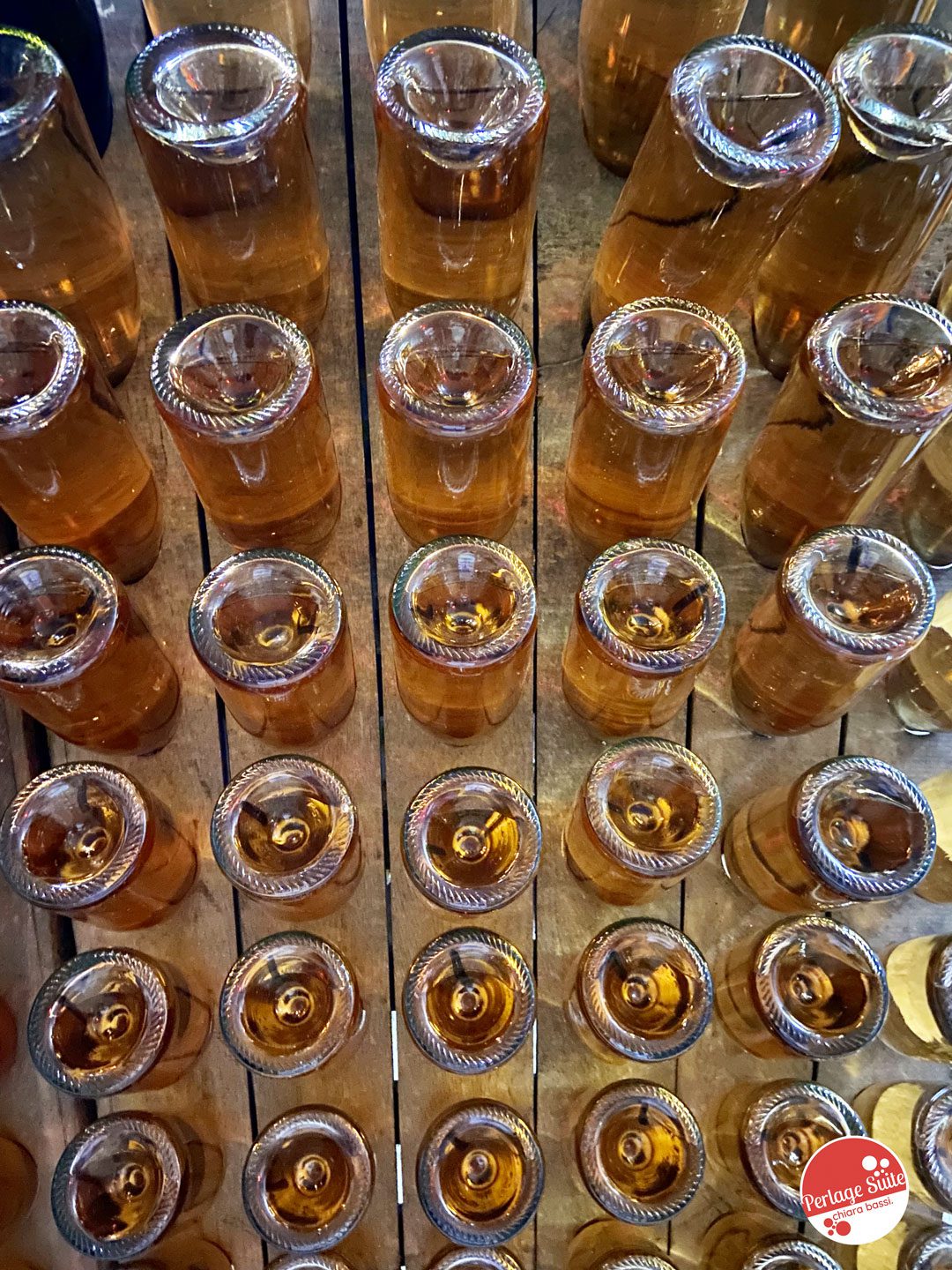Today in Montisola we shot a documentary for an episode of Geo that will be aired on Rai3 next season... I can't wait to know the date! I represented Monte Isola for the gastronomic part and it was an honour to choose a dish to show. So this morning I went to get the catch of the day from Nando Soardi in Carzano. The catch was plentiful: beautiful, big, meaty agoni. So I thought of making casoncelli with a variation of agone: fresh inside and dried outside. The latter is called Monte Isola sardine here and is a Slow Food presidium. To prepare them, I also chose saffron pistils grown here on the island by the Dame Rosse and extra virgin olive oil cultivar Sbresa by Maurizio Ribola. Just one detail: my casoncelli look more like cappelletti... but then again I am Azdora inside!
For those not from Romagna... the Azdora is the careful and passionate guardian of gastronomic traditionse of a region that makes good food and hospitality a cult.
Montisola has a sardine... no, actually it's a agon!
The agone, a delicious lake fish whose shape resembles that of the sardine, is the protagonist of a tradition on Lake Iseo and Monte Isola in particular, so much so that it even gave rise to the surnames Archetti, Archini... from the local dialect archèc by which ash wood bent into an arch was called, in which the fish was dried.
The technique has been handed down over the centuries and seems to date back to the year 1000 when the fishermen of Montisola had to deliver a precise quantity of dried fish annually to the Monastery of Santa Giulia in Brescia. This assignment contributed to the development of handicrafts related to the production of fishing nets and wooden boats, the traditional naét very similar to the Venetian gondolas.
Agon fishing is practised all year round, but reaches its peak in late autumn and winter. The few remaining fishermen go out at dusk and place their sardines - depth nets - in the middle of the lake - at least 200 metres from the shore - anchoring them to buoys. At dawn they return and hoist them up, then immediately eviscerate the shad with a cut in the belly or under the head. At this point the fish is washed in running water and left for at least 2 days in salt before being placed to dry in the sun for about 1 month, again in winter to avoid insects. In summer, drying would then be too fast and therefore unsuitable. One by one, the sardines are threaded into taut threads traditionally tied to the ends of archéts, which were once even in the fishermen's boats themselves. Today, the drying system has been perfected and takes place in larger structures placed on shaded terraces. The shrimp are nailed by the head to hooks on the small wooden planks - arranged in parallel rows - of the frames. Then the pressing takes place: they are placed in a circle in a wooden or stainless steel container and pressed softly to release the fat, which is immediately removed. The shrimp are then covered with olive oil. This method of preservation allows the Monte Isola sardine to last for several months; in fact, the longer it rests, the better it gets! If you change the oil every six months or so, they can last up to two years.
In my experience, after they have been there a few months they are delicious even raw, but traditionally they are eaten seared on the grill or in a pan with a drizzle of extra virgin olive oil, garlic and parsley.
Casoncelli agone (Sardine from Monte Isola) and saffron - Ingredients for 2 persons
For fresh pasta:
- Approx. 180g remilled semolina flour
- 2 medium yellow eggs
For the stuffing with Montisola sardine:
- 100g mascarpone
- 8 fillets of fresh white seabream
- 3 tablespoons breadcrumbs
- 5 fresh basil leaves
- 2 teaspoons 'saffron water
- nutmeg powder
- a pinch of salt
For the dressing:
- 2 dried agoni (Montisola sardine)
- 1 tablespoon extra virgin olive oil from Montisola
- 1 clove of garlic
- fresh basil
- saffron butter QB
For the saffron butter
- 50g butter from centrifuged cream
- saffron pistils from Montisola
- fine salt QB
Casoncelli agone (Montisola sardines) and saffron recipe: Procedure
Step 1: saffron
At least an hour before you start cooking, put the saffron pistils in a coffee cup with 2 tablespoons of lukewarm water. I steeped the saffron pistils the night before for 3 hours. Some people tell you to use hot water, but there is no point because saffron is thermolabile and spoils in the heat... so much so that we will use it 'raw'. Better therefore to be patient to enjoy its delicious fragrance!
Step 2: flavoured butter
Take 50g of butter from centrifuged cream and put it in a bowl. Strain the saffron-scented water through a colander and keep the pistils aside. Add a pinch of fine salt to taste. Whisk very well. Chop the pistils with a knife on the cutting board, add them to the butter and mix well. Put it in the fridge for 10 minutes, then shape it as you like with a pastry cutter. Keep it in the fridge until ready to use.
Step 3: the filling
Chop up the fresh basil with your hands then put it in a bowl with the mascarpone cheese, the tip of a teaspoon of nutmeg and a pinch of fine salt (optional). Fillet 2 shad, remove the bones with the help of tweezers (like eyebrow tweezers) and keep the heads aside. In a non-stick pan put the garlic clove, a tablespoon of oil and a basil leaf. Cook the fillets a couple of minutes on each side, without exaggerating because they will complete cooking inside the pasta. Remove the basil and keep the pan with the garlic, oil and cooking sauce to one side. Transfer the fillets to the bowl with the mascarpone and basil mixture. Add the breadcrumbs. Stir with a spoon and taste: if it is perfect for you, fine, if not, adjust with fine salt and nutmeg. Store in the fridge until ready to use (at least 30 minutes beforehand so that it is perfectly workable).
Step 4: Fresh pasta
Since we are not desperate housewives or homemakers, we use the mixer and pasta machine. In the bowl of the planetary mixer, the remilled durum wheat flour and the eggs. Mix with the dough hook until you get a smooth, homogeneous dough. Knead it with your hands until it forms a ball and cover it with the bowl for about 30 minutes before rolling it out.
N.B. Every flour is different, so you might need a little more or less moisture. If the dough needs moisture, take another egg. Separate the yolk from the egg white and proceed to add the yolk one teaspoon at a time until the consistency is perfect. If the dough is too soft, add a teaspoon of semolina flour or more until the dough no longer sticks to the sides of the bowl.
The dough must be soft and elastic, it absolutely must not stick. Consider that it will gain moisture and become more workable if it sits under the bowl.
Step 5: the gravy
The sauce is essential in any recipe. In this one it is particularly important because, as the recipe is finished raw with saffron butter, it is the sauce in which the pasta is sautéed that binds all the flavours together.
Take the frying pan in which you cooked the shad and put in all the shad heads you have. Brown them in the oil already in the pan, add another tablespoon of oil and, if desired, the tip of a teaspoon of chopped chillies. Fillet the 2 dried agoni and cut them into strips. Add garlic and fresh basil (1 or 2 large leaves) and after 2 to 3 minutes turn off the heat. Remove the garlic clove and the fish heads.
Step 6: How to make casoncelli
Roll out the dough with a pasta machine (I have been using this one from Marcato since 2006: indestructible!) to a thickness of 5 or 6. The thickness of the pasta is a matter of tradition, flavour in the dish and personal taste. I tend to prefer thick pasta, so I choose a thickness of 5, but with this filling a thinner sheet will also be fine. After rolling it out, cut it with a pastry cutter about 4 or 5 cm square. Put a generous teaspoon of filling into each disc. I recommend: generous! Brush the edges with a little water to seal it better. Close by forming a triangle, pulling the dough to the sides without the filling, then turn it in on itself as if to crumple up a candy and pinch/crush the edges. I, being a good Romagnolo instead, closed the dough like a classic cappelletto... it's not my fault, it's my DNA.
Step 7: Cooking and stirring
Take the saffron butter out of the fridge and transfer it to a bowl large enough to hold the pasta. Cook the casoncelli in boiling salted water until they rise to the surface, then use a slotted spoon to transfer them to the pan with the sauce, turn the hob on to low (induction level 3 out of 9) and gently stir with a spoon until the sauce is almost completely absorbed/evaporated. Turn off the cooker and transfer the casoncelli to the bowl with the saffron butter and gently stir with the licker.
Step 8: Serve in a workmanlike manner
Here we enter the realm of food design. Plating correctly is crucial because you eat first and foremost with your eyes. A well-executed plate increases not only the perceived value of the food, but also the feeling of 'good'. First we choose the right colour plate: it must contrast with the ingredients, so we can choose between white and black. The pasta will be bright yellow, but the sardine is dark in colour and begs for the white plate. We choose a nice big plate and put the casoncelli in odd numbers, I would say 7 or 9 maximum since we made them quite big.
Impiety/1: Without overdoing it and staying within the space of genuine home cooking, we can put the casoncelli in the middle with a big spoon... exactly as director Gioacchino Castiglione asked me to do. By the way: congratulations on your professionalism and precision! I'm sure the filming will be wonderful!
Impiety/2: A dish more in my league (i.e. my home cooking)? Arrange the casoncelli in a row, pour the creamy saffron sauce and butter over the casoncelli and arrange the sardine strips in a seemingly haphazard manner. Complete with a vertical head and a basil leaf. Simple, quick and elegant!
You can now buy my book dedicated to sommeliers, aspiring sommeliers and winelovers or scroll down the page to continue reading the article!
Book "Sommelier: the Illustrated Manual" Special Edition 2024
All my notes on wine and food in one book.
€ 38,00 VAT included!
In stock (can be backordered)
Montisola in the heart: casoncelli agone and saffron paired with Marco Mazzucchelli's classic method sparkling wine
Intense, brilliant golden yellow with a fine, numerous and persistent perlage that forms an abundant and evanescent mousse. The nose is intense and fragrant with notes of white chocolate, hazelnuts, brioche bread, amaretto, lemon jam, candied mandarin and acacia flowers. In the mouth it is consistent, crisp, elegant, savoury, fresh and with those evolved notes sche I like so much. Long finish of candied mandarin and saffron butter: that's why it goes wonderfully with our casoncelli agone and saffron! Super!
Finally, I would like to thank Guglielmo Novali - our very talented municipal councillor for tourism and culture - for thinking of me to represent Montisola on this important occasion. I know, I've only been living here for three and a half years... but I feel as much Montisola as I do Romagna, and I wouldn't want to live anywhere else in the world.
Cheers 🍷
Chiara
PS if you liked this article I recommend you read this articleo where I reveal three gastronomic delights of Montisola that I am sure you will fall in love with! If you are thinking of organising a trip to Montisola, you can find information on this website.

